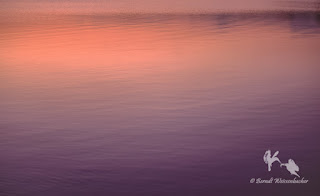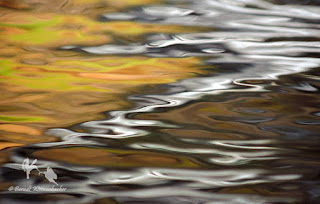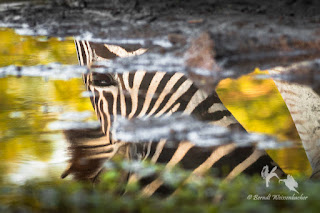In a previous post I explained why water as a substance holds such fascination for me, particularly so as a
photographer. As a child, I experienced real freedom, unfettered by over-protective
parents – days spent out-of-doors in the immense Highveld grasslands, dry and
dusty, far from home, in the company only of a small band of loveable rascals.
Any encounter with water was a rare occurrence for us youngsters, be it a
stream, a river, a dam or – on a few travels with our parents – the ocean. The
coolness, the flow, water’s ceaselessly changing nature, its might, held us in
thrall.
At school, I was
taught that water, as a compound, is colourless and odourless. It took me quite
a while to realise that the teachers were speaking of pure water, uncontaminated by any solutes and any suspended
particles, a substance so pure that I had never been exposed to it. And, while
the teachers were right, to me water has always remained a fascinating enigma.
It is colourful by reflection and
diffraction of sunlight or because it harbours cyanobacteria, algae and other
organisms, or because it is mixed with countless other chemicals. It does smell too, again because water
never occurs in its pure form in nature on our planet.
Water is weird.
Although the atoms that comprise a water molecule (when taken together) are
less massive than the atoms that make up a hydrogen sulphide molecule, water is
liquid at room temperature rather than a gas. Water also clings: it coheres to
itself (forming spherical raindrops and hailstones and suspended droplets on
branches or grass culms following rain or dense mist) and it adheres to a
multitude of other substances (a natural ‘glue’ that holds lumps of soil
together, for example). Pure water has its highest density at 4°C, so that ice
floats instead of sinking, and deep lakes never freeze all the way through to
their bottom. Water heats up much more slowly, but, similarly, once heated, it
also loses heat much more slowly than air or rock and sand. The presence of a
large amount of water in the environment, either on the surface (as seas or
large lakes), in the soil or stored inside vegetation (which also releases
moisture into the atmosphere by evapotranspiration) tends to reduce the
fluctuations in temperature of the terrestrial environment from day to night
and from season to season. Water also has low viscosity, flowing easily down
the slightest of slopes, or vanishing between the tiniest of cracks on rock or
spaces in sandy soil. Moreover, water is a massive enough, incompressible
liquid that scours, erodes, and sculpts even the hardest of rock surfaces.
As water
evaporates from the vast surface of the oceans, clouds are formed and condensed
water droplets, carrying no dissolved minerals, fall back to the surface as
precipitation. Some of the moisture will be blown off course by winds and will
fall, not back into the seas, but onto the solid surfaces of the islands and
continents. This pure, fresh water will accumulate dissolved chemicals as it
percolates downwards through the soil and porous rock strata, but it will never
attain the much higher concentrations of solutes found in the oceans.
The water will
continue to flow downwards, unless it is prevented from doing so by impervious
rock strata. It will collect underground if trapped or it will emerge onto the
surface of the slopes of the land as springs. From here it will continue its
downward journey, forming rivulets and streams, or filling depressions in the
landscape as pools and lakes.
As weird and
wonderful as water is physically and chemically, for me it is the flow of this vital
substance and its ability to reflect light that mesmerise. Silent, smooth, un-rippled
and gentle in one instance, eliciting tranquil thoughts, moods and emotions;
thunderous, dangerous, life-threatening on the next occasion, bringing forth
excitement, bewilderment and even fear.
The speed and
shape of the flow and the different colours of water seem interminable, and yet
these bewitching phenomena are simply manifestations of the underlying action
of the fundamental physical forces of the universe. The knowledge and
experience that there exist substances, and interactions between substances,
and actions of forces upon these substances and their interactions – actions
and reactions, processes and patterns – that are at the same time fully
explainable, determined and constrained by the forces of nature, and yet
endlessly mutable as an outcome, to me have offered meaning, beauty and awe in
equal measure throughout my life.
For humans and
the vast majority of all the other terrestrial inhabitants of Earth fresh water
is vital for continued existence. Only around 3% of the total quantity of water
that can be found in the biosphere carries a dissolved mineral content low
enough to be considered safe for the consumption by species that ply their
trade on continents and islands. And this vital resource is diminishing rapidly
as our own species continues to exploit and pollute any and all sources of
fresh water on the planet surface, still believing, as we do, in ancient
mythologies that professed that we, Homo
sapiens, are the masters of it all and that Earth, and indeed the entire
universe, exist because of us, for us. As our ceaseless slumber
continues and we remain embedded and comforted by out-dated and misguided
beliefs, as yet unpolluted, consumable sources of water are speedily becoming
an exceptionally rare reserve planet-wide. And as this vital, life-supporting
liquid dwindles on Earth’s surface, both in quality and quantity on our ever
rapidly-heating planet, so too evaporate any hopes of a future for humankind
that is meaningful, tolerable and peaceful. Fresh
water is running out fast.







No comments:
Post a Comment